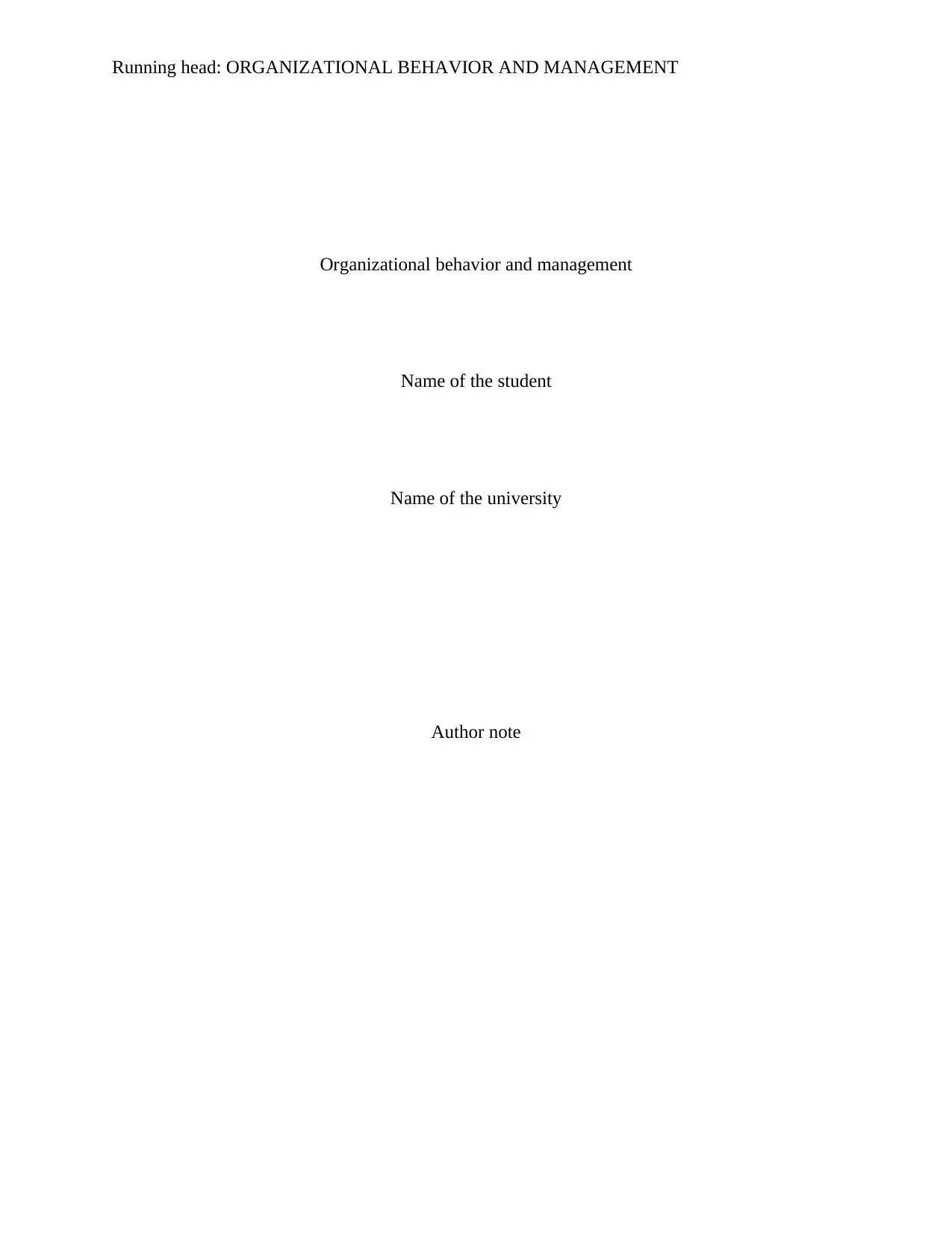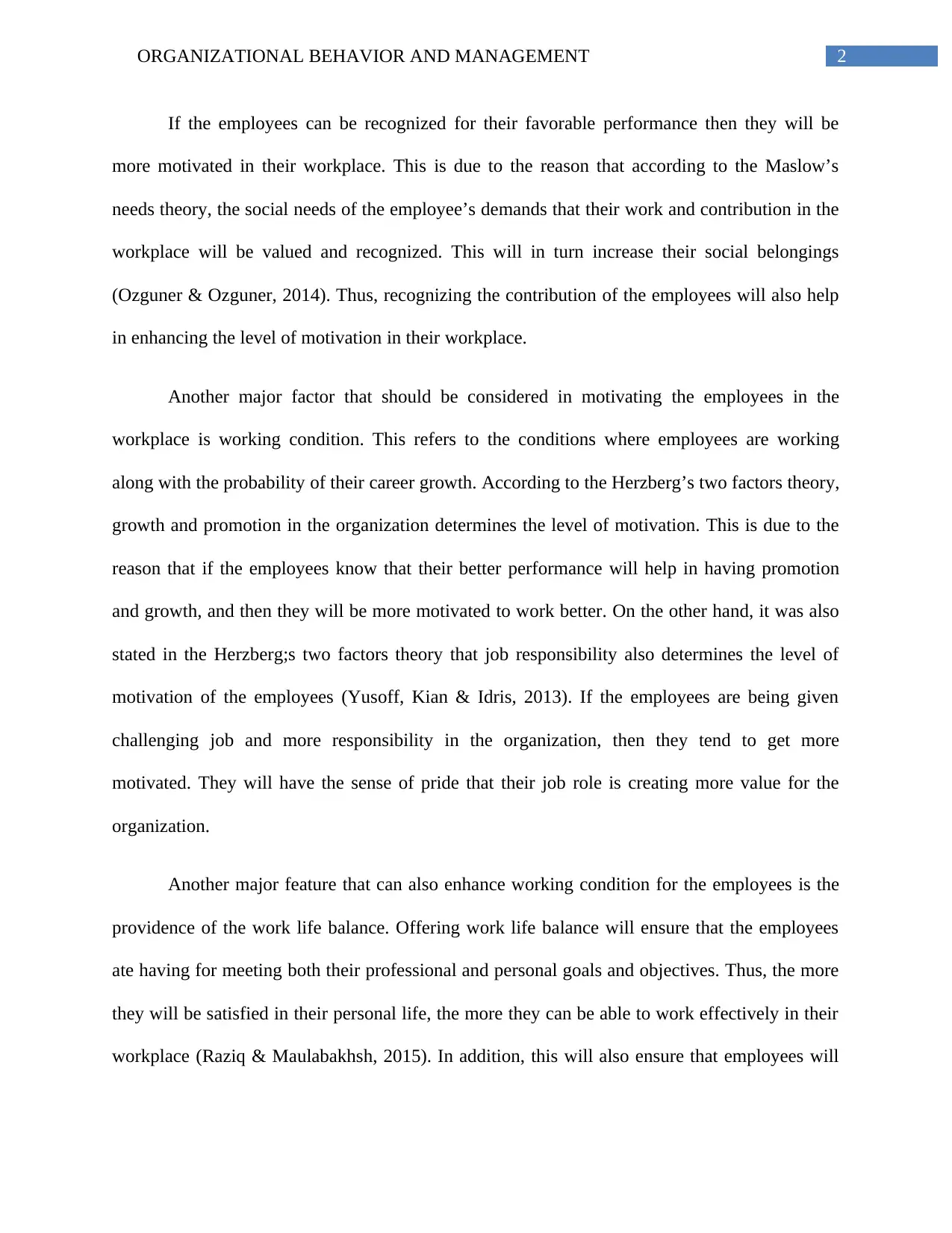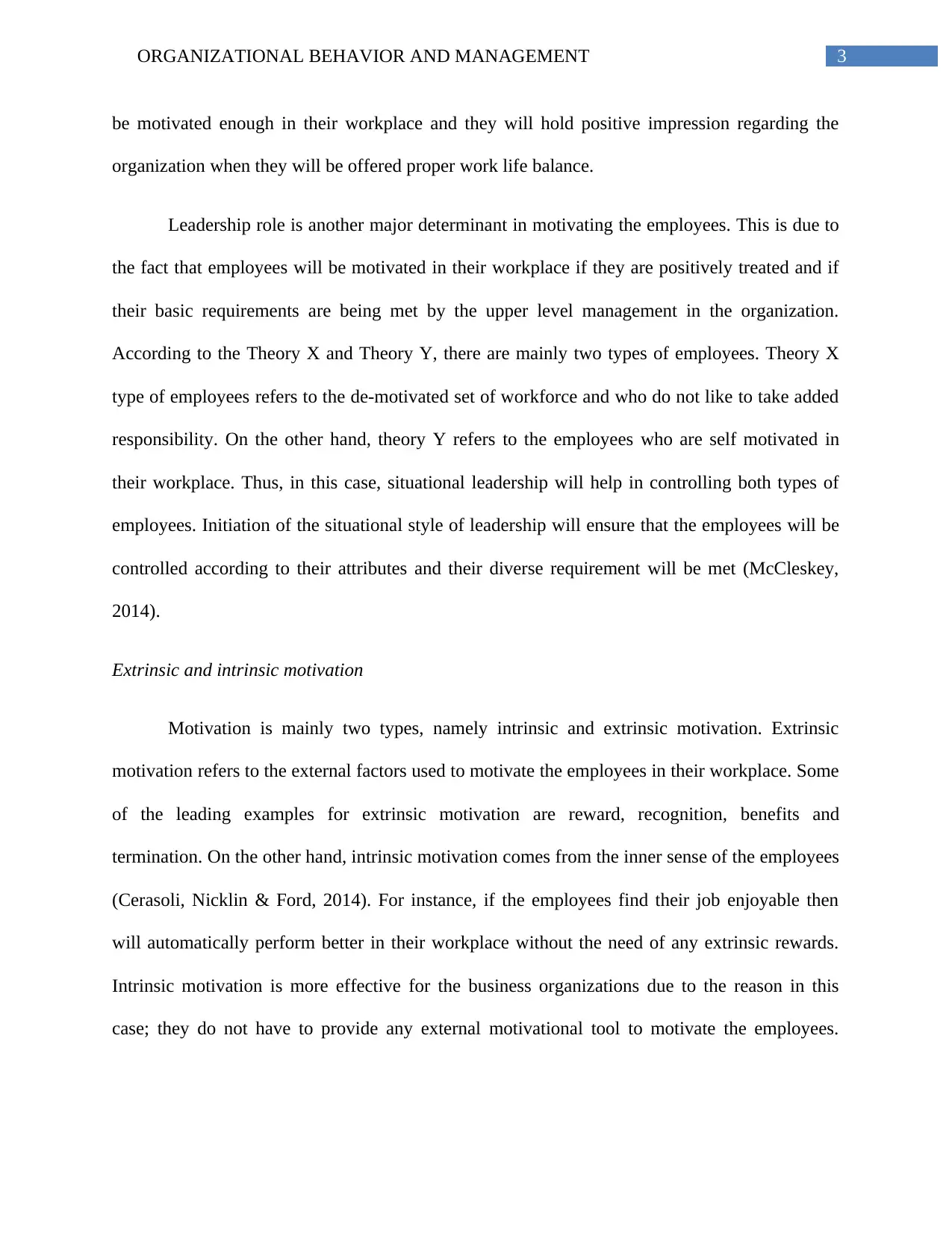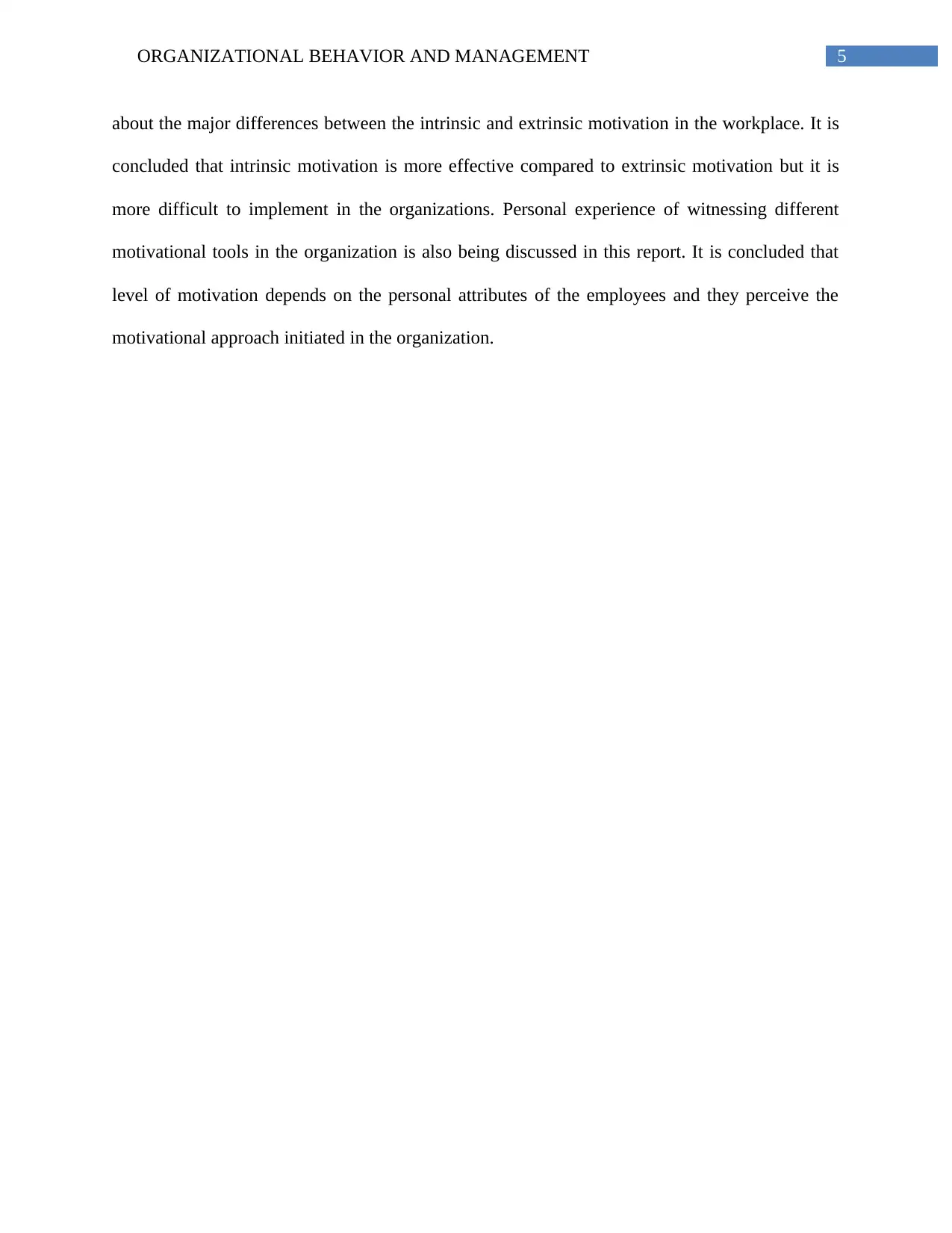Improving Employee Motivation: Organizational Behavior & Management
VerifiedAdded on 2021/05/30
|7
|1695
|38
Essay
AI Summary
This essay explores strategies for improving employee motivation within organizations, contrasting intrinsic and extrinsic motivation and applying motivational theories like Maslow's hierarchy of needs and Herzberg's two-factor theory. It emphasizes financial benefits, recognition, working conditions, work-life balance, and leadership styles as key factors. The author reflects on personal experiences with extrinsic motivation, advocating for a greater focus on intrinsic motivation through improved working conditions and engaging job design. The essay concludes that effective motivation depends on individual employee attributes and the perceived value of motivational approaches, with Desklib offering additional resources for students.

Running head: ORGANIZATIONAL BEHAVIOR AND MANAGEMENT
Organizational behavior and management
Name of the student
Name of the university
Author note
Organizational behavior and management
Name of the student
Name of the university
Author note
Paraphrase This Document
Need a fresh take? Get an instant paraphrase of this document with our AI Paraphraser

1ORGANIZATIONAL BEHAVIOR AND MANAGEMENT
Introduction
In the current business scenario, motivation level of the employees determines the
effectiveness and performance of the organizations. This is due to the reason that the more
motivated will be the employees, the more will be their organizational commitment and
engagement in the organization (Lazaroiu, 2015). Having higher level of motivation also helps in
regulating the issues that can get emerged in the organizations between the internal stakeholders.
This essay will discuss about the different ways that can help in improving the level of
motivation of the employees. In addition, the differences between the intrinsic and extrinsic
motivation will also be discussed in this report. Different motivational theories will be used to
critically analyze the effectiveness of motivation in the organization.
Different ways in improving motivation
One of the major ways of improving the motivation level of the employees is proving
them favorable financial benefits along with providing job security and other facilities. These
factors will help in improving the motivation level of the employees. This is due to the reason
that the core objective of the employees in working is to achieve financial stability. Thus proving
them favorable financial benefits will help to enhance the level of motivation of the employees.
According to the Maslow’s need theory, it is important for the organizations to meet the safety
needs of the employees in order to motivate them in their workplace. Safety needs includes the
financial safety also (Jerome, 2013). On the other hand, Maslow’s need theory also states that it
is important for the organizations to provide reward and recognition for the employees. These
factors are termed as the social and esteem needs. Rewarding the employees for the better
performance will further help them to get motivated to work better in future.
Introduction
In the current business scenario, motivation level of the employees determines the
effectiveness and performance of the organizations. This is due to the reason that the more
motivated will be the employees, the more will be their organizational commitment and
engagement in the organization (Lazaroiu, 2015). Having higher level of motivation also helps in
regulating the issues that can get emerged in the organizations between the internal stakeholders.
This essay will discuss about the different ways that can help in improving the level of
motivation of the employees. In addition, the differences between the intrinsic and extrinsic
motivation will also be discussed in this report. Different motivational theories will be used to
critically analyze the effectiveness of motivation in the organization.
Different ways in improving motivation
One of the major ways of improving the motivation level of the employees is proving
them favorable financial benefits along with providing job security and other facilities. These
factors will help in improving the motivation level of the employees. This is due to the reason
that the core objective of the employees in working is to achieve financial stability. Thus proving
them favorable financial benefits will help to enhance the level of motivation of the employees.
According to the Maslow’s need theory, it is important for the organizations to meet the safety
needs of the employees in order to motivate them in their workplace. Safety needs includes the
financial safety also (Jerome, 2013). On the other hand, Maslow’s need theory also states that it
is important for the organizations to provide reward and recognition for the employees. These
factors are termed as the social and esteem needs. Rewarding the employees for the better
performance will further help them to get motivated to work better in future.

2ORGANIZATIONAL BEHAVIOR AND MANAGEMENT
If the employees can be recognized for their favorable performance then they will be
more motivated in their workplace. This is due to the reason that according to the Maslow’s
needs theory, the social needs of the employee’s demands that their work and contribution in the
workplace will be valued and recognized. This will in turn increase their social belongings
(Ozguner & Ozguner, 2014). Thus, recognizing the contribution of the employees will also help
in enhancing the level of motivation in their workplace.
Another major factor that should be considered in motivating the employees in the
workplace is working condition. This refers to the conditions where employees are working
along with the probability of their career growth. According to the Herzberg’s two factors theory,
growth and promotion in the organization determines the level of motivation. This is due to the
reason that if the employees know that their better performance will help in having promotion
and growth, and then they will be more motivated to work better. On the other hand, it was also
stated in the Herzberg;s two factors theory that job responsibility also determines the level of
motivation of the employees (Yusoff, Kian & Idris, 2013). If the employees are being given
challenging job and more responsibility in the organization, then they tend to get more
motivated. They will have the sense of pride that their job role is creating more value for the
organization.
Another major feature that can also enhance working condition for the employees is the
providence of the work life balance. Offering work life balance will ensure that the employees
ate having for meeting both their professional and personal goals and objectives. Thus, the more
they will be satisfied in their personal life, the more they can be able to work effectively in their
workplace (Raziq & Maulabakhsh, 2015). In addition, this will also ensure that employees will
If the employees can be recognized for their favorable performance then they will be
more motivated in their workplace. This is due to the reason that according to the Maslow’s
needs theory, the social needs of the employee’s demands that their work and contribution in the
workplace will be valued and recognized. This will in turn increase their social belongings
(Ozguner & Ozguner, 2014). Thus, recognizing the contribution of the employees will also help
in enhancing the level of motivation in their workplace.
Another major factor that should be considered in motivating the employees in the
workplace is working condition. This refers to the conditions where employees are working
along with the probability of their career growth. According to the Herzberg’s two factors theory,
growth and promotion in the organization determines the level of motivation. This is due to the
reason that if the employees know that their better performance will help in having promotion
and growth, and then they will be more motivated to work better. On the other hand, it was also
stated in the Herzberg;s two factors theory that job responsibility also determines the level of
motivation of the employees (Yusoff, Kian & Idris, 2013). If the employees are being given
challenging job and more responsibility in the organization, then they tend to get more
motivated. They will have the sense of pride that their job role is creating more value for the
organization.
Another major feature that can also enhance working condition for the employees is the
providence of the work life balance. Offering work life balance will ensure that the employees
ate having for meeting both their professional and personal goals and objectives. Thus, the more
they will be satisfied in their personal life, the more they can be able to work effectively in their
workplace (Raziq & Maulabakhsh, 2015). In addition, this will also ensure that employees will
⊘ This is a preview!⊘
Do you want full access?
Subscribe today to unlock all pages.

Trusted by 1+ million students worldwide

3ORGANIZATIONAL BEHAVIOR AND MANAGEMENT
be motivated enough in their workplace and they will hold positive impression regarding the
organization when they will be offered proper work life balance.
Leadership role is another major determinant in motivating the employees. This is due to
the fact that employees will be motivated in their workplace if they are positively treated and if
their basic requirements are being met by the upper level management in the organization.
According to the Theory X and Theory Y, there are mainly two types of employees. Theory X
type of employees refers to the de-motivated set of workforce and who do not like to take added
responsibility. On the other hand, theory Y refers to the employees who are self motivated in
their workplace. Thus, in this case, situational leadership will help in controlling both types of
employees. Initiation of the situational style of leadership will ensure that the employees will be
controlled according to their attributes and their diverse requirement will be met (McCleskey,
2014).
Extrinsic and intrinsic motivation
Motivation is mainly two types, namely intrinsic and extrinsic motivation. Extrinsic
motivation refers to the external factors used to motivate the employees in their workplace. Some
of the leading examples for extrinsic motivation are reward, recognition, benefits and
termination. On the other hand, intrinsic motivation comes from the inner sense of the employees
(Cerasoli, Nicklin & Ford, 2014). For instance, if the employees find their job enjoyable then
will automatically perform better in their workplace without the need of any extrinsic rewards.
Intrinsic motivation is more effective for the business organizations due to the reason in this
case; they do not have to provide any external motivational tool to motivate the employees.
be motivated enough in their workplace and they will hold positive impression regarding the
organization when they will be offered proper work life balance.
Leadership role is another major determinant in motivating the employees. This is due to
the fact that employees will be motivated in their workplace if they are positively treated and if
their basic requirements are being met by the upper level management in the organization.
According to the Theory X and Theory Y, there are mainly two types of employees. Theory X
type of employees refers to the de-motivated set of workforce and who do not like to take added
responsibility. On the other hand, theory Y refers to the employees who are self motivated in
their workplace. Thus, in this case, situational leadership will help in controlling both types of
employees. Initiation of the situational style of leadership will ensure that the employees will be
controlled according to their attributes and their diverse requirement will be met (McCleskey,
2014).
Extrinsic and intrinsic motivation
Motivation is mainly two types, namely intrinsic and extrinsic motivation. Extrinsic
motivation refers to the external factors used to motivate the employees in their workplace. Some
of the leading examples for extrinsic motivation are reward, recognition, benefits and
termination. On the other hand, intrinsic motivation comes from the inner sense of the employees
(Cerasoli, Nicklin & Ford, 2014). For instance, if the employees find their job enjoyable then
will automatically perform better in their workplace without the need of any extrinsic rewards.
Intrinsic motivation is more effective for the business organizations due to the reason in this
case; they do not have to provide any external motivational tool to motivate the employees.
Paraphrase This Document
Need a fresh take? Get an instant paraphrase of this document with our AI Paraphraser

4ORGANIZATIONAL BEHAVIOR AND MANAGEMENT
However, initiation of the intrinsic motivation is more difficult and complex to implement
compared to the implementation of the extrinsic motivation.
I was previously worked for a leading multinationals for 3 years as the marketing
executive. We were provided different benefits and perks in order to keep us motivated.
However, in these 3 years, I saw that they are more concentrated towards providing external
factors for motivating the employees. This caused different level of motivation among the
employees. This is due to the reason that not all the employees were got motivated by having
financial benefits. Some others also wished to have proper work life balance. I was among them
who had no got motivated by the financial benefits gained. This is due to the fact that I was more
inclined toward having positive personal life.
Therefore, for me they should have initiated intrinsic motivational process in order to
have self motivated employees in place. According to me, they should have improved the
working condition in order to create a positive impression among the employees. If the
employees were given proper working condition, then they were self motivated to work in the
workplace. In addition, they should also design the job roles in more interesting manner such as
division of job, job enhancement and job enrichment. This would have helped in enhancing the
interest of the employees in performing their respective job roles.
Conclusion
Thus, it can be concluded that there are number of options available in enhancing the
level of motivation of the employees. Some of the major steps are being discussed in this essay.
Moreover, some of the motivational theories are being discussed in this report in order to analyze
the effectiveness of the discussed steps in motivating the employees. This essay also discussed
However, initiation of the intrinsic motivation is more difficult and complex to implement
compared to the implementation of the extrinsic motivation.
I was previously worked for a leading multinationals for 3 years as the marketing
executive. We were provided different benefits and perks in order to keep us motivated.
However, in these 3 years, I saw that they are more concentrated towards providing external
factors for motivating the employees. This caused different level of motivation among the
employees. This is due to the reason that not all the employees were got motivated by having
financial benefits. Some others also wished to have proper work life balance. I was among them
who had no got motivated by the financial benefits gained. This is due to the fact that I was more
inclined toward having positive personal life.
Therefore, for me they should have initiated intrinsic motivational process in order to
have self motivated employees in place. According to me, they should have improved the
working condition in order to create a positive impression among the employees. If the
employees were given proper working condition, then they were self motivated to work in the
workplace. In addition, they should also design the job roles in more interesting manner such as
division of job, job enhancement and job enrichment. This would have helped in enhancing the
interest of the employees in performing their respective job roles.
Conclusion
Thus, it can be concluded that there are number of options available in enhancing the
level of motivation of the employees. Some of the major steps are being discussed in this essay.
Moreover, some of the motivational theories are being discussed in this report in order to analyze
the effectiveness of the discussed steps in motivating the employees. This essay also discussed

5ORGANIZATIONAL BEHAVIOR AND MANAGEMENT
about the major differences between the intrinsic and extrinsic motivation in the workplace. It is
concluded that intrinsic motivation is more effective compared to extrinsic motivation but it is
more difficult to implement in the organizations. Personal experience of witnessing different
motivational tools in the organization is also being discussed in this report. It is concluded that
level of motivation depends on the personal attributes of the employees and they perceive the
motivational approach initiated in the organization.
about the major differences between the intrinsic and extrinsic motivation in the workplace. It is
concluded that intrinsic motivation is more effective compared to extrinsic motivation but it is
more difficult to implement in the organizations. Personal experience of witnessing different
motivational tools in the organization is also being discussed in this report. It is concluded that
level of motivation depends on the personal attributes of the employees and they perceive the
motivational approach initiated in the organization.
⊘ This is a preview!⊘
Do you want full access?
Subscribe today to unlock all pages.

Trusted by 1+ million students worldwide

6ORGANIZATIONAL BEHAVIOR AND MANAGEMENT
Reference
Cerasoli, C. P., Nicklin, J. M., & Ford, M. T. (2014). Intrinsic motivation and extrinsic
incentives jointly predict performance: A 40-year meta-analysis. Psychological
bulletin, 140(4), 980.
Jerome, N. (2013). Application of the Maslow’s hierarchy of need theory; impacts and
implications on organizational culture, human resource and employee’s
performance. International Journal of Business and Management Invention, 2(3), 39-45.
Lazaroiu, G. (2015). Employee motivation and job performance. Linguistic and Philosophical
Investigations, 14, 97.
McCleskey, J. A. (2014). Situational, transformational, and transactional leadership and
leadership development. Journal of Business Studies Quarterly, 5(4), 117.
Ozguner, Z., & Ozguner, M. (2014). A managerial point of view on the relationship between of
Maslow's hierarchy of needs and Herzberg's dual factor theory. International Journal of
Business and Social Science, 5(7).
Raziq, A., & Maulabakhsh, R. (2015). Impact of working environment on job
satisfaction. Procedia Economics and Finance, 23, 717-725.
Yusoff, W. F. W., Kian, T. S., & Idris, M. T. M. (2013). Herzberg’s Two Factors Theory On
Work Motivation: Does Its Work For Todays Environment. Global journal of commerce
and Management, 2(5), 18-22.
Reference
Cerasoli, C. P., Nicklin, J. M., & Ford, M. T. (2014). Intrinsic motivation and extrinsic
incentives jointly predict performance: A 40-year meta-analysis. Psychological
bulletin, 140(4), 980.
Jerome, N. (2013). Application of the Maslow’s hierarchy of need theory; impacts and
implications on organizational culture, human resource and employee’s
performance. International Journal of Business and Management Invention, 2(3), 39-45.
Lazaroiu, G. (2015). Employee motivation and job performance. Linguistic and Philosophical
Investigations, 14, 97.
McCleskey, J. A. (2014). Situational, transformational, and transactional leadership and
leadership development. Journal of Business Studies Quarterly, 5(4), 117.
Ozguner, Z., & Ozguner, M. (2014). A managerial point of view on the relationship between of
Maslow's hierarchy of needs and Herzberg's dual factor theory. International Journal of
Business and Social Science, 5(7).
Raziq, A., & Maulabakhsh, R. (2015). Impact of working environment on job
satisfaction. Procedia Economics and Finance, 23, 717-725.
Yusoff, W. F. W., Kian, T. S., & Idris, M. T. M. (2013). Herzberg’s Two Factors Theory On
Work Motivation: Does Its Work For Todays Environment. Global journal of commerce
and Management, 2(5), 18-22.
1 out of 7
Related Documents
Your All-in-One AI-Powered Toolkit for Academic Success.
+13062052269
info@desklib.com
Available 24*7 on WhatsApp / Email
![[object Object]](/_next/static/media/star-bottom.7253800d.svg)
Unlock your academic potential
Copyright © 2020–2025 A2Z Services. All Rights Reserved. Developed and managed by ZUCOL.





